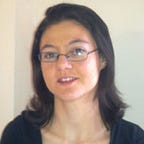When do pupils make progress in writing?
In the last two blogs, we introduced our age-independent writing score which allows you to measure the progress of pupils in different primary year groups. In this blog we’ll discuss a few of the insights this gives you.
As a reminder, here’s the graph with all six primary year groups on it (with the caveat that work in year 2 & 6 was completed in less independent conditions).
Here are four insights we can get from this. I’ll restrict this discussion to years 1, 3, 4 & 5 given the issues with years 2 & 6.
One obvious and expected finding is the gap between the different year groups. The average score for each year group is represented by the peak of each curve. The peak of the purple year 5 curve is furthest to the right, as year 5s have the highest average score. The peak of the pink year 1 curve is furthest to the left, as year 1s have the lowest average score. That’s obviously as you’d expect.
However, this graph also lets you see something that is less easy to predict — the overlaps between the different year groups. For example, look at the way the right hand slope of the pink year 1 curve overlaps with the left hand side of the purple year 5 curve. This shows that a proportion of year 1 pupils have higher scores than a proportion of year 5 pupils.
A third interesting finding is that the gaps between year groups decrease as the pupils get older. Look just at the peaks for years 3, 4 and 5, which represent the average scores for those year groups. The gap between year 3 and year 4 is quite large. The gap between 4 and 5 is much narrower. We don’t yet have year 2 data derived from similar conditions, but if we can imagine a peak in between years 1 & 3, it looks like the gaps between 1 & 2 and 2 & 3 would also be larger than those between 4 & 5. This finding is borne out by other research (eg, see here and here) which also suggests that pupils make more progress in the early years than in later years.
A fourth interesting finding relates to the spread of achievement in each year group, which is represented visually on the chart by the width of each curve. In year one, there is quite a wide spread of achievement. The range runs all the way from 268 to 573, and the standard deviation is 43. In years 3, 4, and 5, the curves get narrower. This shows the spread between the highest and lowest attainers in each year group is lower in year 5 than it is in year 1.
Is this to be expected? It’s hard to say as there aren’t many other similar assessments of writing out there! Looking at a large US assessment of pupils in grades 4 & 8, we find that there, the spread in reading doesn’t change, whilst that in maths has the reverse pattern to what we see here: that is, the range of achievement widens as pupils get older. Why might we have seen the opposite pattern in our data? We can’t say for sure. Some possible explanations are that good teaching is helping weaker pupils to catch up. It might also be something unique to the nature of learning to write — that pupils tend to converge on a standard. Or it might also be something to do with the types of tasks and conditions that have been selected. We will keep investigating!
You can read more about Assessing Primary Writing and get involved here.
